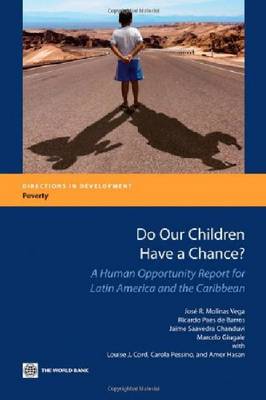Directions in Development. Poverty
1 total work
Do Our Children Have a Chance?
by Jose R. Molinas Vega, Ricardo Paes de Barros, Jaime Saavedra Chanduvi, and Marcelo Giugale
Published 16 November 2011
The Latin America and Caribbean (LAC) region is making progress in opening the doors of development to all. But it still has a long way to go. At the current pace, it would take, on average, a generation for the region to achieve universal access to the basic services that make for human opportunity. Intra-county regional disparities are large, and barely converging.
This book assesses the status and evolution of human opportunity in LAC. It builds on the 2008 publication, Measuring Inequality of Opportunity, in several directions. First, it uses newly-available data to expand the set of opportunities and personal circumstances under analysis. The data is representative of some 200 million children living in 19 countries over the last 15 years. Second, it compares human opportunity in LAC with that of developed countries, among them the U.S. and France, two very different models of social policy. This allows for illuminating exercises in benchmarking and extrapolation. And third, it looks at human opportunity within countries - across regions, states and cities. This gives us a preliminary glimpse at the geographic dimension of equity, and at the role that different federal structures play.
This book assesses the status and evolution of human opportunity in LAC. It builds on the 2008 publication, Measuring Inequality of Opportunity, in several directions. First, it uses newly-available data to expand the set of opportunities and personal circumstances under analysis. The data is representative of some 200 million children living in 19 countries over the last 15 years. Second, it compares human opportunity in LAC with that of developed countries, among them the U.S. and France, two very different models of social policy. This allows for illuminating exercises in benchmarking and extrapolation. And third, it looks at human opportunity within countries - across regions, states and cities. This gives us a preliminary glimpse at the geographic dimension of equity, and at the role that different federal structures play.
